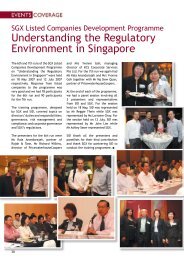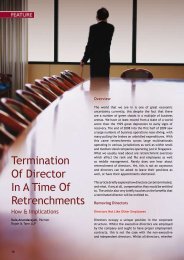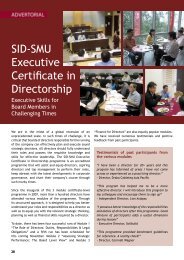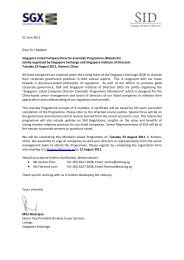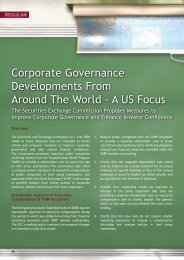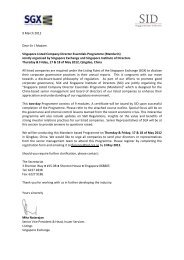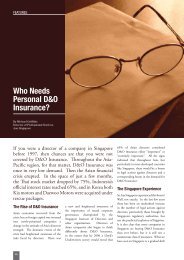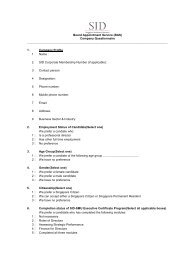Disclosure of Non-Executive Director and CEO Remuneration in ...
Disclosure of Non-Executive Director and CEO Remuneration in ...
Disclosure of Non-Executive Director and CEO Remuneration in ...
- No tags were found...
You also want an ePaper? Increase the reach of your titles
YUMPU automatically turns print PDFs into web optimized ePapers that Google loves.
<strong>Disclosure</strong> <strong>of</strong> <strong>Non</strong>-<strong>Executive</strong><strong>Director</strong> <strong>and</strong> <strong>CEO</strong><strong>Remuneration</strong> <strong>in</strong> S<strong>in</strong>gaporeMak Yuen TeenK. K. Lalanika Vasanthi1Mak Yuen Teen is co-director <strong>of</strong> the CorporateGovernance <strong>and</strong> F<strong>in</strong>ancial Report<strong>in</strong>g Centre(CGFRC) at the National University <strong>of</strong>S<strong>in</strong>gapore <strong>and</strong> regional research director(Asia-Pacific) at Watson Wyatt Worldwide. K.K.Lalanika Vasanthi is manager <strong>of</strong> the CGFRC.10The S<strong>in</strong>gapore Code <strong>of</strong> Corporate Governance(Code) was updated <strong>in</strong> 2005<strong>and</strong> became effective on 1 January2007. With respect to remunerationmatters, the Code recommends thatthere should be a <strong>Remuneration</strong> Committee(RC) compris<strong>in</strong>g entirely <strong>of</strong>non-executive directors, the majority<strong>of</strong> whom, <strong>in</strong>clud<strong>in</strong>g the Chairman,should be <strong>in</strong>dependent. Each companyshould provide clear disclosure <strong>of</strong> itsremuneration policy, level <strong>and</strong> mix <strong>of</strong>remuneration, <strong>and</strong> the procedure forsett<strong>in</strong>g remuneration. The Code goeson to say that the board should <strong>in</strong>cludewith<strong>in</strong>, or annexed to its f<strong>in</strong>ancialstatements, a report on the remuneration<strong>of</strong> directors <strong>and</strong> at least the topfive key non-director executives. As am<strong>in</strong>imum, the report should disclosethe names <strong>of</strong> the relevant <strong>in</strong>dividualswhose remuneration falls with<strong>in</strong> b<strong>and</strong>s<strong>of</strong> $250,000. This is an improvement tothe SGX List<strong>in</strong>g Manual Chapter 12 thatonly requires disclosure <strong>of</strong> the number<strong>of</strong> directors whose remuneration fallswith<strong>in</strong> the follow<strong>in</strong>g b<strong>and</strong>s: $500,000<strong>and</strong> above, $250,000 to $499,999 <strong>and</strong>below $250,000.Notably, the Code does not specifyan upper limit to the b<strong>and</strong>s. Thisimplies, for example, that if thehighest remunerated director received$825,000, then the upper b<strong>and</strong> tobe disclosed would be $750,000 to$999,999. The Code further states thatwith<strong>in</strong> each b<strong>and</strong>, there needs to bea breakdown (<strong>in</strong> percentage terms) <strong>of</strong>each director’s remuneration earnedthrough base or fixed salary, variableor performance-related <strong>in</strong>come orbonuses, benefits-<strong>in</strong>-k<strong>in</strong>d, <strong>and</strong> longterm<strong>in</strong>centives. The Code furtherrecommends that, as best practice,companies should fully disclose theremuneration <strong>of</strong> each <strong>in</strong>dividualdirector.In this article, we report the results<strong>of</strong> a survey <strong>of</strong> disclosures relatedto remuneration matters. Data onremuneration disclosure practiceswere collected from the latestavailable annual reports <strong>of</strong> 684companies listed <strong>in</strong> S<strong>in</strong>gapore fromMay to July 2007. The sample <strong>in</strong>cluded521 Ma<strong>in</strong>board companies <strong>and</strong> 163Sesdaq (now Catalist) companies but
excluded trusts, funds <strong>and</strong> REITS.These companies had board sizesrang<strong>in</strong>g from 3 to 16 directors, with anaverage size <strong>of</strong> 7.1. Composition <strong>of</strong> <strong>Remuneration</strong>Committee95% <strong>of</strong> companies disclosed that theyhave a RC <strong>and</strong> the same percentagedisclosed the full name list <strong>of</strong> theRC members. 56% have a majority <strong>of</strong><strong>in</strong>dependent directors on the RC while34% have all <strong>in</strong>dependent directors.89% said that the RC is chaired by an<strong>in</strong>dependent non-executive director.86% <strong>of</strong> the companies disclosedthe attendance <strong>of</strong> RC members atcommittee meet<strong>in</strong>gs.2. <strong>Non</strong>-<strong>Executive</strong> <strong>Director</strong><strong>Remuneration</strong>Guidel<strong>in</strong>e 8.2 <strong>of</strong> the Code recommendsthat “the remuneration <strong>of</strong> non-executivedirectors should be appropriate tothe level <strong>of</strong> contribution, tak<strong>in</strong>g <strong>in</strong>toaccount factors such as effort <strong>and</strong>time spent, <strong>and</strong> responsibilities <strong>of</strong>the directors”. The survey found that11% <strong>of</strong> companies said that their NEDswere paid additional fees for be<strong>in</strong>gcommittee chairs <strong>and</strong> 22% said thattheir NEDs were paid additional fees forbe<strong>in</strong>g committee members. 10% paidattendance fees to NEDs for attend<strong>in</strong>gboard, committee or annual generalmeet<strong>in</strong>gs <strong>and</strong> 2% paid additional feesto NEDs for other reasons.2.1 <strong>Disclosure</strong> <strong>of</strong> remunerationamounts for NEDs45 companies, compris<strong>in</strong>g 42 Ma<strong>in</strong>board<strong>and</strong> 3 Sesdaq companies, disclosedexact remuneration for each NED byname. One <strong>of</strong> the Ma<strong>in</strong>board companiesdisclosed the exact remuneration <strong>of</strong> itsdirectors by name but did not disclosewhich ones were non-executive.Therefore, only 7% <strong>of</strong> companiesfollowed the Code’s encouragementfor companies, as best practice, t<strong>of</strong>ully disclose exact remuneration <strong>of</strong>each director. The table below showsthe distribution <strong>of</strong> the companies bytheir market capitalisation.542 companies compris<strong>in</strong>g 395Ma<strong>in</strong>board <strong>and</strong> 147 Sesdaq companiesdisclosed NED remuneration <strong>in</strong> b<strong>and</strong>s.For both Ma<strong>in</strong>board <strong>and</strong> SesdaqTable 1: Number <strong>of</strong> CompaniesDisclos<strong>in</strong>g Exact NED <strong>Remuneration</strong>by Market CapitalisationMarketCapitalisation(SGD)Number <strong>of</strong>companies> 1 billion > 500 million 3< 500 million 19SesdaqTotal6companies that had disclosed NEDremuneration <strong>in</strong> b<strong>and</strong>s, the mostcommonly used b<strong>and</strong> is “0 – 250,000”(S<strong>in</strong>gapore dollars). However, therewere 18 other b<strong>and</strong>s found for theMa<strong>in</strong>board companies, <strong>and</strong> six otherb<strong>and</strong>s found for the Sesdaq companies,such as “0-100,000” <strong>and</strong> “0-150,000”.Notably, all the Ma<strong>in</strong>board <strong>and</strong>Sesdaq companies had disclosed NEDremuneration us<strong>in</strong>g a b<strong>and</strong> with aceil<strong>in</strong>g, with “
• base salary (<strong>in</strong>clud<strong>in</strong>g CPFcontributions);• short-term <strong>in</strong>centives (STIs) typically<strong>in</strong> the form <strong>of</strong> bonuses;• long-term <strong>in</strong>centives (LTIs) typically<strong>in</strong> the form <strong>of</strong> share options; <strong>and</strong>/or• benefits.Given the focus <strong>of</strong> corporategovernance on the creation <strong>of</strong> longtermshareholder value, long-term<strong>in</strong>centives have grown <strong>in</strong> importance<strong>in</strong>ternationally as a component <strong>of</strong> theremuneration <strong>of</strong> <strong>CEO</strong>s <strong>and</strong> other seniorexecutives. Similarly, we expect longterm<strong>in</strong>centives for <strong>CEO</strong>s <strong>and</strong> seniorexecutives to become more important<strong>in</strong> S<strong>in</strong>gapore.3.1 <strong>Disclosure</strong> <strong>of</strong> remunerationamounts for <strong>CEO</strong>sCompared to disclosure <strong>of</strong> exactremuneration <strong>of</strong> NEDs, an even smallernumber <strong>of</strong> companies (approximately5%) made exact disclosure <strong>of</strong> <strong>CEO</strong>remuneration. The majority <strong>of</strong>companies disclosed <strong>in</strong> b<strong>and</strong>s, with‘competitive reasons’ be<strong>in</strong>g themost commonly cited reason for notdisclos<strong>in</strong>g exact <strong>CEO</strong> remuneration.There were 36 companies (<strong>in</strong>clud<strong>in</strong>gfour Sesdaq companies) that madeexact <strong>CEO</strong> remuneration disclosure.The market capitalisation <strong>of</strong> thecompanies are shown <strong>in</strong> the tablebelow.<strong>in</strong> S<strong>in</strong>gapore by S<strong>in</strong>gTel, is for theboard to adopt a policy encourag<strong>in</strong>g itsNEDs to own shares <strong>in</strong> the company upto, say, the equivalent <strong>of</strong> one year <strong>of</strong>NED fees <strong>and</strong> to hold those shares untilthey leave the board. This is to betteralign the directors’ <strong>in</strong>terests with the<strong>in</strong>terests <strong>of</strong> long-term shareholders.3. <strong>CEO</strong> <strong>Remuneration</strong>Pr<strong>in</strong>ciple 8 states that the “a significantproportion <strong>of</strong> executive directors’remuneration should be structured soas to l<strong>in</strong>k rewards to corporate <strong>and</strong>12<strong>in</strong>dividual performance”. Guidel<strong>in</strong>e 8.1recommends that “the performancerelatedelements <strong>of</strong> remunerationshould be designed to align <strong>in</strong>terests<strong>of</strong> executive directors with those<strong>of</strong> shareholders <strong>and</strong> l<strong>in</strong>k rewards tocorporate <strong>and</strong> <strong>in</strong>dividual performance”<strong>and</strong> that “there should be appropriate<strong>and</strong> mean<strong>in</strong>gful measures for thepurpose <strong>of</strong> assess<strong>in</strong>g executivedirectors’ performance”.The remuneration mix for <strong>CEO</strong>stypically consists <strong>of</strong> the follow<strong>in</strong>gcomponents:Table 2: Number <strong>of</strong> CompaniesDisclos<strong>in</strong>g Exact <strong>CEO</strong> <strong>Remuneration</strong>by Market CapitalisationMarket Number <strong>of</strong>Capitalisation companies(SGD)> 1 billion 6> 500 million 2< 500 million 14SesdaqTotal6
536 companies (compris<strong>in</strong>g <strong>of</strong> 390Ma<strong>in</strong>board <strong>and</strong> 146 Sesdaq companies)disclosed the remuneration <strong>of</strong> their <strong>CEO</strong>s<strong>in</strong> b<strong>and</strong>s. Similar to NED remuneration,the most commonly used b<strong>and</strong> by bothMa<strong>in</strong>board <strong>and</strong> Sesdaq companies was“0 – S$250,000”. The second mostcommonly used b<strong>and</strong> by companies was“S$250,000 – S$500,000”. There were42 other b<strong>and</strong>s found for Ma<strong>in</strong>boardcompanies <strong>and</strong> 11 other b<strong>and</strong>s foundfor Sesdaq companies.Of the companies which disclosed<strong>CEO</strong> remuneration <strong>in</strong> b<strong>and</strong>s, 19% <strong>of</strong>the Ma<strong>in</strong>board companies <strong>and</strong> 12%<strong>of</strong> the Sesdaq companies did notspecify an upper limit, with the mostcommonly used uncapped amountbe<strong>in</strong>g “>$500,000”.3.2 <strong>CEO</strong> remuneration mixOf the 36 companies which disclosedexact <strong>CEO</strong> remuneration, 28 paid their<strong>CEO</strong>s bonuses rang<strong>in</strong>g from $6,000 tojust over $4 million. The percentage <strong>of</strong>the <strong>CEO</strong>’s bonus relative to the basesalary for these <strong>CEO</strong>s ranged from 7%to 1857%, with a median <strong>of</strong> 74 %.N<strong>in</strong>e companies separately disclosedthe amount paid to pension schemesor CPF for their <strong>CEO</strong>s, while mostcompanies disclosed that the salary<strong>and</strong> bonus amounts <strong>in</strong>cluded CPFcontributions <strong>and</strong> other allowances.Thirteen companies disclosed benefitsfor their <strong>CEO</strong>s rang<strong>in</strong>g from $3,800 tonearly $360,000. Benefits disclosed<strong>in</strong>clude: medical <strong>and</strong> dental benefits,car allowance, club memberships,group <strong>in</strong>surance, hous<strong>in</strong>g allowance,other allowances <strong>and</strong> benefits-<strong>in</strong>-k<strong>in</strong>d.Twenty-three companies granted shareoptions to their <strong>CEO</strong>s, rang<strong>in</strong>g from 100,000to 1 million options. The vest<strong>in</strong>g schedulesranged from three to ten years.4. <strong>Disclosure</strong> <strong>of</strong> remunerationamounts <strong>of</strong> top executivesOnly 1% <strong>of</strong> the companies (compris<strong>in</strong>gentirely <strong>of</strong> Ma<strong>in</strong>board companies)disclosed the exact remuneration <strong>of</strong>their senior management, exclud<strong>in</strong>gthe executive directors. 80% <strong>of</strong> thecompanies, compris<strong>in</strong>g <strong>of</strong> 399 Ma<strong>in</strong>board<strong>and</strong> 145 Sesdaq companies disclosed theremuneration <strong>of</strong> their key executives<strong>in</strong> b<strong>and</strong>s. The ma<strong>in</strong> reason given fordisclos<strong>in</strong>g <strong>in</strong> b<strong>and</strong>s or non-disclosure wasdue to competitive reasons.Most <strong>of</strong> the companies disclosed theremuneration <strong>in</strong> b<strong>and</strong>s <strong>of</strong> $250,000(e.g. S$250,000 – S$500,000; S$500,000– S$750,000), with “S$150,000” to“>S$1,750,000”.5. ConclusionIn this article, we reported on theresults <strong>of</strong> survey <strong>of</strong> disclosures relatedto remuneration matters <strong>in</strong> annualreports <strong>of</strong> SGX-listed companies.Only about 7% disclosed the exactremuneration <strong>of</strong> each <strong>in</strong>dividual NED,5% disclosed exact <strong>CEO</strong> remuneration,<strong>and</strong> 1% disclosed exact remuneration<strong>of</strong> their senior management other thanthe executive directors.Although disclosure <strong>of</strong> remuneration<strong>of</strong> directors <strong>and</strong> senior executivesgenerally rema<strong>in</strong>s poor <strong>in</strong> Asia, HongKong now requires the disclosure <strong>of</strong>exact remuneration <strong>of</strong> each <strong>in</strong>dividualdirector <strong>in</strong> its list<strong>in</strong>g rules. This hasbrought Hong Kong closer to thest<strong>and</strong>ards <strong>of</strong> developed markets suchas U.S., U.K. <strong>and</strong> Australia. Beyondthe poor disclosures <strong>of</strong> remunerationamounts <strong>and</strong> mix, S<strong>in</strong>gaporecompanies also typically do notdisclose performance metrics for theexecutive directors. While pr<strong>in</strong>ciple9 <strong>of</strong> the Code recommends thatcompanies “should provide disclosure<strong>in</strong> relation to its remuneration policiesto enable <strong>in</strong>vestors to underst<strong>and</strong>the l<strong>in</strong>k between remuneration paidto directors <strong>and</strong> key executives, <strong>and</strong>performance”, most companies do notcurrently do so.Given the number <strong>of</strong> companieswhich are controlled by families ormanagement, <strong>and</strong> the ability <strong>of</strong> family<strong>and</strong> management shareholders tocontrol the appo<strong>in</strong>tment <strong>of</strong> <strong>in</strong>dependentdirectors, <strong>in</strong>clud<strong>in</strong>g those serv<strong>in</strong>g onremuneration committees, the poordisclosures <strong>of</strong> remuneration amounts,mix <strong>and</strong> policies create a real risk thatdirectors <strong>and</strong> key executives are ableto extract excessive remunerationwhich hurt m<strong>in</strong>ority shareholders.We believe the S<strong>in</strong>gapore shouldconsider mov<strong>in</strong>g our disclosurest<strong>and</strong>ards relat<strong>in</strong>g to remunerationmatters closer to practices <strong>in</strong> the moredeveloped markets. The developedmarkets operat<strong>in</strong>g on a disclosurebasedregime considers high st<strong>and</strong>ards<strong>of</strong> remuneration disclosures as one <strong>of</strong>the key elements <strong>of</strong> such a regime,<strong>and</strong> not someth<strong>in</strong>g which should beleft to the discretion <strong>of</strong> companies orto market forces. n13



